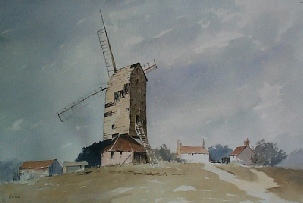
History of Foulness Island
Extract from: the excellent ‘Heritage Guide’ by Rochford District Council
 The island’s name derives from ‘Fulganaess’, the Old English for wild birds nest, and today the area remains a sanctuary to great colonies of wading birds, including oyster catcher, red shank, avocets and Brent geese.
The island’s name derives from ‘Fulganaess’, the Old English for wild birds nest, and today the area remains a sanctuary to great colonies of wading birds, including oyster catcher, red shank, avocets and Brent geese.
The earliest known occupants of Foulness and the smaller islands were the Romano-British. Archaeological evidence tells us that a civilian settlement existed at Little Shelford in the south-west of the Island, this consisted of a cemetery where cremation urns were recovered, some with evidence of human remains inside. Archaeological excavation of the site has revealed that farming, fishing and in particular the cultivation of oysters was taking place, but it would appear the production of salt was the main industry in this area at this particular time. The pottery excavated gives us a date for occupation as the late first century AD. The site appears to be abandoned circa 280-230 AD due to the flooding caused by rising sea levels. The first recorded reference of sea walls on the Island was in “The Charter Rolls” for 1271 AD.
Foulness was originally shared between five mainland parishes: Rochford, Sutton, Little Wakering, Shopland, and Little Stambridge all in the Rochford Hundred. These parishes held detached rights on Foulness. The inhabitants had to pay tithes to those parishes on whose land they dwelt, this lasted until all the Islands’ tithes were commuted to money payment in 1847.
Archaeological evidence suggests that the first substantial quality domestic dwellings were constructed in the sixteenth century; however more recent archaeological excavation (2001-03) shows high status living existed on the Island in the fourteenth-fifteenth century. There appears to have been three major building phases on the Island: Mid-16th century, late 17th century - early 18th century, late 19th century - early 20th century. The first brick built dwellings were constructed in the early 18th century.

During the medieval period the Island was populated by shepherds and fishermen. Arable farming was taking place, but Foulness was well known for its dairy produce. The marshlands were ideal for grazing sheep and cheese, meat and ewe’s milk were in plentiful supply. The sheep also provided wool for the wool trade which was at its height in England during the medieval period.
The population began to increase in numbers from the sixteenth century due mainly to the development of arable farming on the island. During the seventeenth century Dutch names appear in the Parish registers. One theory put forward for this is they were leaving the lowlands to escape the protestant persecutions. By the late nineteenth century the population had risen to almost 800.
The church has played a leading role in relation to the moral development of Foulness over the past 720 years. In 1283 a chapel was built on the Island to serve the small community and in particular those who could not receive divine service in their own detached parish. The chapel was replaced during The Tudor period by a wooden church, which was in turn replaced by the present church St. Mary the Virgin in 1850.
In 1846 The Church of England Primary School was built to take 120 children, it was extended in 1872 to take a further 52 children. In 1988 the school became redundant due to the small number of children attending (11). The school remained empty for 13 years but after negotiations between Defence Estates and The Foulness Conservation and Archaeological Society it was renovated and is now “The Foulness Heritage Centre”. Foulness has seen some prominent Lords of the manor.
At the time of Domesday it was Suene, then Hubert de Burgh, followed by Sir John de Rochford, the De Bohuns, and the Rich Family. The manor became part of the estates owned by the Finch Family in 1688, when Daniel Finch 2nd Earl of Nottingham married Lady Essex Rich one of six coheirs of the Rich family. The manor remained in the Finch Family until the death of Alan Finch in 1910; it was his successor Wilfred Henry Montgomery Finch who sold the Lordship to the War Department on the 13th July 1915.



© 2015 - Richard Kirton - All Rights Reserved | Privacy Policy | Terms of Use | Site Map

